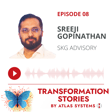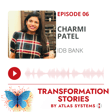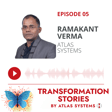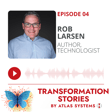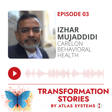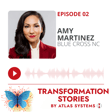Become a Creator today!Start creating today - Share your story with the world!
Start for free
00:00:00
00:00:01

#1: Saravanan Kunju
At the heart of the often-conservative banking industry, how do we make technological transformation happen? Saravanan Kunju describes his journey as an IT leader in the financial services space – at IDB Bank, and earlier with J. P. Morgan Chase and other major players. He tells how IDB accelerated to a modern database environment, embraced AI-driven platforms, and created a successful team approach to change.
Recommended
Transcript
Introduction to Transformation Stories
00:00:00
Speaker
This is Transformation Stories, a podcast from Atlas Systems, exploring how companies are leaping into the future through deliberate change and innovation. In today's digital landscape, businesses face a choice to transform or risk falling behind.
00:00:18
Speaker
Here the insights of visionaries and changemakers were driving transformation across various industries and roles. They'll share their experiences, strategies, and the most potent opportunities for success. Join us as we uncover the secrets of transformation.
Meet Samravanan Kunju from IDB Bank
00:00:37
Speaker
I'm Dave Stanton, Chief Marketing Officer of Atlas Systems. Our guest today is Samravanan Kunju, a high-performing digital banking technology transformation and innovation leader with over 15 years of strong financial services experience. He's a strategic leadership partner dedicated to supporting business development and the CIO Advisory Services Group.
00:01:03
Speaker
Currently, he is first vice president and head of data engineering, production apps, and infrastructure with IDB Bank. In the past, Kudju has worked with such financial institutions as JPMorgan Chase, Citibank, and American Express. All right, Saravan and Kudju, it's great to welcome you to Atlas Systems, Transformation Stories. Thank you for joining us.
00:01:29
Speaker
Good afternoon, Dave. Thank you for inviting me. It's a pleasure to speak with you today. Thank you. That's great to have you. I wonder if we could start by just having you tell us a little about your role at IDP. I am the head of database engineering, also data services as well. So the bank is Israel-based community bank. It's over almost $14 billion assets.
00:01:59
Speaker
And my role is across the bank, bank-wide. It's not specific to a specific line of business. The whole bank, whatever the database requirements that I take are end-to-end services. Whether it could be on-premise or it could be a cloud or it could be a third party hosting services. So I am the point of contact for enterprise database
00:02:28
Speaker
provisioning, monitoring, administration, and data services. And what types of data? I mean, can you just give us an example of what types of data you're talking about? Yeah, sure. Most of the data, I would say, at the moment, 90% of the data that we are dealing with relational data, which consists of numerical and alpha numerical type of data.
00:02:59
Speaker
And down the road, you know, we are, as we are growing on the business side and there's a potential opportunity to have some kind of unstructured data, which is what, you know, in the industry side is growing and we are very early stage of it. So I'm expecting that, you know, unstructured data to grow down the road probably from 2024 onwards. Right now my footprint is
00:03:28
Speaker
90% structured data and 10% unstructured data.
Insights on Digital Transformation
00:03:33
Speaker
And how have you seen sort of the type of work that you're doing transform in the time that you've been doing it? Yeah, we are doing, we are investing our time on a day-to-day basis major on digital transformation. So, excuse me. When I say digital transformation, digital transformation is a process of integrating
00:03:57
Speaker
technologies into every aspect of the bank and the technology organization. So we're trying to leverage the new technologies that are in the market and how to improve our business operations using those technologies, leading to a faster processes, reduce waste age and manual cost, improved quick decision making skills,
00:04:27
Speaker
and also to have a better user experience too. Some other topics I would say that in the digital transformation space, it could be mobile technology or cloud technology integration, or it could be 5G integration on an IoT internet of things and big data. When we say big data, it could be
00:04:57
Speaker
mostly unstructured data that's coming on the fly as a stream. It could be text messages or it could be some kind of a very large binary objects, something combination of those. And we are not there yet, artificial intelligence and machine learning and data science. Probably 2024, there'll be a potential opportunity when we have that data strategy project and we kick in.
00:05:27
Speaker
you know, and another one is RPA, probiotic process automation.
Efficiency with Delfix Technology
00:05:33
Speaker
We extensively at the bank, we invest on RPA to automate a lot of manual processes that the bank was doing before. And digital wins is another one. So example, like in a database space, in my role, what I do is if I want to give
00:05:54
Speaker
data for a specific day or for a specific point in time you know our customers will ask for hey I need the data as of 3.15 p.m. from March 31st this type of request this used to take a week or sometimes because it's almost three months older data it is in our tape and sometimes tape they don't hold it more than
00:06:22
Speaker
I would say a few weeks and it goes to a remote place and from remote place you got requested to bring it on site and restore the data the whole process takes I would say anywhere between a week to two weeks new and I'm what I'm doing is I'm implementing a digital product called Delfix
00:06:46
Speaker
So the tool Delfix is a very niche tool. It's a California based Silicon Valley based tool that allows to build a digital data pipeline where our end users, customers, you know, they can get the data that they need instantly. They don't need to wait for it. So starting from production, the data is injected into this Delfix platform.
00:07:12
Speaker
and then Delfix replicates the data in a secure way to, you know, the remote destination. And then the user can go to a portal on the browser, they can do it, you know, log into the portal and then they can get the data that they went on. Just simply like a two, three clicks. Rather than spending two weeks of time, all they're gonna spend is maximum of five minutes.
00:07:38
Speaker
So how do you find that the different people involved or affected by the transformation react to it? How do they respond, you know, typically on board or what's that process like? Overall it's IT project initiatives. So there is a project management, program management involved.
00:07:59
Speaker
who drives as an enterprise model project. It's not just individual silo base. So it's all well, you know, tracked projects. And we have some timelines as well. So for each of those, you know, milestones, we know that, you know, who are the implementers and who are the dependencies. We do document in the front of the, you know, implementation.
00:08:27
Speaker
We identify who are the potential key resources for this in order to implement. And then what is the sequence? What is the timeline for everything? And then what is the dependencies? So we go in that order. And then we materialize. We review that multiple times. And then we kick off. Then we do the implementation. So in terms of engaging the people, it's all internal
Collaboration and Partner Ratios
00:08:52
Speaker
bank. Internal bank users, most of the time, I would say,
00:08:57
Speaker
60% of the time we deal with internal bank employers or consultants and 40% more of third party vendors who used to provide services for business application or other nature such as Salesforce is one of them.
00:09:22
Speaker
or Oracle Cloud or third-party vendors like Atlas or anybody else at Microsoft, it could be something like that. So it's a 60-40 ratio, I would say. And what are some of the other elements of a successful transformation as
Mobile and Self-Service Technologies
00:09:42
Speaker
you've seen it? What does it take to make it stick? Well, we never had mobile-based technologists in the bank
00:09:50
Speaker
The customers, when a new customer comes, the first thing that they ask is, Hey, do you have mobile apps? Okay. And five years ago, we never had it. And then the customer right away, they will walk in. And today we have a lot of mobile-based apps and self-service capabilities for, you know, through the bank website where customers can securely do the transaction rather than, you know, going to your bank.
00:10:18
Speaker
going to branch or pay for the weapons of fee, you know, everything can be automated through self-service capabilities too. So those are two major advantages from an end user standpoint. Are there any other sort of situations or qualities or ways of approaching it that you think make the transformation more successful?
Navigating Technical Challenges
00:10:48
Speaker
Yes, we do pretty much possible, but there are some areas where it's on a journey where when we do things, when we implement, and I would say 90%, we covered 10% where we did not expect. It's a kind of, because it's a huge challenge where the bank example, like we used to have a paper base, everything. We never had a system
00:11:16
Speaker
even for any change approval. People used to print a Word document and then they go around it and then they get the signature from various managers and impacted people to make some system production changes. Today we are using ServiceNow as kind of a project tracking tool, project management tool, also incident management and change management.
00:11:43
Speaker
So part of the journey, we noticed some gaps early in the process because we are moving from a paper-based process to complete digital transformation. When we do very large projects like that, always some challenges will be there. So these are all technical challenges. It's not a process challenge.
00:12:07
Speaker
Process challenge is very well, this is some list, they do identify and they are very dedicated for that. But technical challenges we face when we are hosting cloud solution or hybrid cloud solution and also something like that.
Leadership in Innovation
00:12:27
Speaker
And in terms of leadership, I mean, as a leader, as someone who's guiding a transformation, do you have any
00:12:34
Speaker
suggestions or things that you think that a good transformational leader needs to do or say? Yes. The good leaders really, they have to spend time on innovation and reaching out to what are the new tools in order to get to the digital transformation. What tools I need to invest? What is the right tools? There may be tools like thousands of tools may be there.
00:13:03
Speaker
What is the right tool for your business model, for your business strength or for your business scale to get that economies of scale? What is the right tool to inverse here? There's a cost of capital involved.
00:13:19
Speaker
And then there's an opportunity cost. So the leader really truly needs to understand and you know, an example, I will tell you in my experience, I work with my former CAO very closely. David Smithers. He's a very pioneer in the digital transformation. It's a very phenomenal experience working with him and
00:13:45
Speaker
I appreciate all of his direct guidance that he contributed to the organization. That really helped us. What about skilling and talent? How does that work into the equation in terms of giving people new skills or getting the right people in place?
Skills Investment for Future Tech
00:14:06
Speaker
Every organization now, they invest a lot of time and money for people to
00:14:14
Speaker
You know update the skills now technology is keep changing major change every two years or three years That's a huge technology changes Two decades ago. It was not that you know, but now
00:14:27
Speaker
You know, we said cloud now after, you know, before everything used to be on-premise. And then it was a little bit of hybrid cloud model. Then past, I would say a decade, mostly organizations now, they love the cloud, cloud technology. Now, what is after cloud? Now, if you think about it's AI, artificial intelligence, mission learning and data science and combination three, that brings
00:14:57
Speaker
a lot of potential opportunities where a lot of things that we do today, manual basis that can be automated tremendously, okay. That will cause, there could be some IT, like a blue scholar jobs to get, you know, read, I would say to get evaporated. Also it will sit in or fit in a different,
00:15:23
Speaker
places where people can get their skills and then working. The AI will definitely help to do more automation of services and it will internally, it will cause a lot of cybersecurity jobs to open. That's another thing. So cybersecurity is one of the potential area down the road it's going to grow. Are there any other potential sources of transformation that you see apart from AI?
00:15:52
Speaker
A lot of cloud integration nowadays, customers are very happy to do so.
Cloud Models and Exit Strategies
00:15:58
Speaker
That's the thing. Cloud is a challenging one. Sometimes cloud people think it's cheaper. It's not always cheaper. You need to, cloud is a big ocean. So when you go put your footprint there, before you go there, you need to understand how the cloud works. What are the different type of cloud works?
00:16:19
Speaker
Is there a sas cloud or is cloud or pass cloud or whatever cloud that we are talking about? So thoroughly understand the exit barrier There are sometimes You know folks They miss that exit barrier Okay, I will give you an example where people think AWS AWS is a market leader but
00:16:46
Speaker
AWS is a kind of a monopoly game compared to other clouds. The products that AWS, they own, it doesn't work in other public cloud. Whether it could be a Microsoft Azure cloud or Google cloud or Oracle cloud or IBM Watson. Whereas you take Microsoft SQL server or Oracle database that can work in any cloud.
00:17:15
Speaker
So folks need to understand the exit barrier. If you don't understand the exit barrier, then it's going to cost of capital probably five years from now or 10 years from now. These are the big challenges that anyone can think of. And they need to really do a prerequisite type of impact analysis and better understand the cloud and carefully implement
00:17:43
Speaker
And what is your size of the organization? Always, you know, we need to think. And how much I can observe, you know, on the cost of capital. So those are the things, you know, I would say.
Oracle SaaS Cloud Success
00:17:59
Speaker
And can you, I know you've mentioned a few examples, but is there a specific story in your history, your work of transformation that you think is particularly resonant and powerful?
00:18:15
Speaker
So one of the example I would say Oracle SaaS Cloud, we implemented in my journey in the past five years. So it's a massive change. And we work with Oracle Cloud partners. And it's a very good experience where moving from Oracle Private Cloud, which was about to close and threatening us
00:18:44
Speaker
I need to move in a timely fashion where we thought we cannot. We need to pay some additional fees and stay for some more time until the complete SAS cloud that takes place. But the partners that we work with this phenomenal experience and they completed in a timely fashion. And we thought after the implementation of SAS cloud,
00:19:14
Speaker
It's going to cause more noise. Absolutely, as of today, I would say three years now completed. I don't see any noises there. So that's a very surprising experience for me. Where I was expecting more noises or more challenges, but it's very seamless and very transparent implementation.
00:19:41
Speaker
A huge success goes to all the technical team members in the bank, and also the third-party vendors that we work with for Oracle's SaaS Cloud implementation. Can you think of other ways that partners like Atlas can help you drive transformation? Absolutely. Any vendors, they may have their own tool, they may have their own processes, or they may have their own hybrid cloud data centers.
00:20:09
Speaker
So definitely that will help for partnering with, I'm not saying specifically to Atlas, definitely similar to Atlas. There'll be potential opportunities. Again, we have to carefully review what the vendors have, how that's good to help, you know, the bank future strategy. We always have, you know, have like a three year strategy and five year strategy.
00:20:38
Speaker
In the past, we used to have five-year strategy. Now we are exchanging the three-year strategy. So what we are going to do in the next three years, how to efficiently do that? For that reason, definitely that will help.
Continuous Learning for Growth
00:20:54
Speaker
And just thinking about your own career, I mean, do you see any examples of transformation or do you see yourself continuing to transform in your own work? Is that a goal of yours?
00:21:08
Speaker
Absolutely, that's correct. I don't want to do like a same thing over and over I would like to do a lot of new things as the technology grows how to bring up the new technology and how to improve the day-to-day operation Where that could potentially save a lot of cost. Okay, that's another thing similarly I came from where
00:21:36
Speaker
a very large bank, JP Mohan Chase to ADB Bank five years ago. So my journey is totally coming from like a work pretty close to like a $4 trillion bank to just a $12 billion assets. Okay. And even when I joined the bank, it was not like a $12 billion asset. It was only $6 billion assets. And within the four, four and a half years or five years, they have been growing tremendously. And today they are on 14 billion dollar asset.
00:22:06
Speaker
and they keep growing as part of the journey. I'm bringing a lot of value adding services that I gained in JPMorgan Chase. Not all of them will fit for the new bank because some tools, some processes that I implemented need not to be helpful for the new organization because that fits the model that we did that works in a bigger platform. It may not be working for smaller customers.
00:22:36
Speaker
So, thoroughly understanding, you know, the technologies and processes and client requirements, that's the key and need to be carefully evaluated and implemented. It's a constant journey to learn, think and implement the right strategy for the right organization. What's been great talk to you, Saravan, and really appreciate your time today. My pleasure. Thank you for joining us.
00:23:05
Speaker
Likewise, thank you.
Embracing Change for Business Success
00:23:07
Speaker
And that's a wrap on today's episode of Transformation Stories. If you found this episode as enlightening as we did, be sure to subscribe, rate, and leave a review. Your feedback fuels our mission to bring you more thought-provoking conversations. As we conclude today's journey, remember that transformation is within reach for every business, and it starts with deliberate choices. Keep pushing boundaries, seeking new opportunities, and embracing change.
00:23:35
Speaker
Until next time, this is Transformation Stories.

